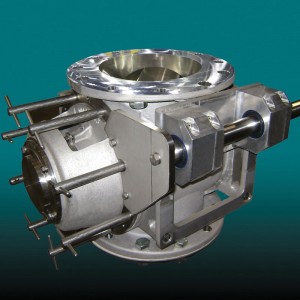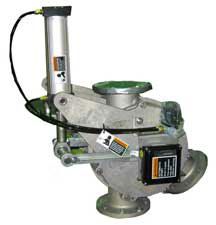Vacuum
 Vacuum conveying can be used in both dense phase and dilute phase technologies. The advantage of vacuum conveying is the flexibility to draw from a multiple sources to a single destination. Vacuum conveying also puts the process conveying system under negative pressure so that any leaks do not cause dusting to the outside environment.
Vacuum conveying can be used in both dense phase and dilute phase technologies. The advantage of vacuum conveying is the flexibility to draw from a multiple sources to a single destination. Vacuum conveying also puts the process conveying system under negative pressure so that any leaks do not cause dusting to the outside environment.
Pressure
Pressure conveying can also be used in both dense phase and dilute phase technologies. The advantage of pressure conveying is typically you can use less airflow and smaller convey line sizes to accomplish similar conveying rates as vacuum conveying. The pressure system is more beneficial with conveying from one source to multiple destinations. The other advantage of pressure conveying is the capability to go much further distances, up to 1200 to 1500 feet in certain applications. Pressure conveying systems also allow the process piping to vent directly into bins or silos.
Dilute Phase
Dilute phase system meters a material flow into an airflow. There is a point where the material loading will exceed the capability of the airflow to keep the material suspended and the system will become unstable. Typically the pick-up air velocities of range from 3800-4800 ft./m. This technology can be used in both pressure and vacuum conveying systems.
Dense Phase
 Dense phase conveying systems meter an airflow into a material flow. Typically the material moves down the convey piping in a slug flow. The typical conveying velocities can be from 500-2000 ft./m. The advantage of this technology is handling fragile or abrasive materials. This technology can be used in both pressure and vacuum systems.
Dense phase conveying systems meter an airflow into a material flow. Typically the material moves down the convey piping in a slug flow. The typical conveying velocities can be from 500-2000 ft./m. The advantage of this technology is handling fragile or abrasive materials. This technology can be used in both pressure and vacuum systems.
Negative Airlift
Negative airlift systems are a variation of vacuum dilute conveying systems. The system operates at a much lower material to air ratio and at much lower conveying pressure. However, the airflow requirements are typically much higher for similar capacity systems. These systems are often powered by fans and not by positive displacement blowers.
Filter Receiver
A filter receiver is the destination filter for the conveying system. For a vacuum conveying system, this system requires a rotary airlock or other type of isolation device to maintain the pressure differential of the system while simultaneously discharging the conveyed product. In a vacuum dense phase system, this unit is typically rated for full vacuum. Dilute phase systems require this unit to be rated for 17” Hg. vacuum pressure
Rotary Airlocks
 A rotary airlock is a machined rotating device with close fitting clearances between the rotor and the external housing. This unit allows material to be continuously discharged from a vacuum receiver while maintaining the vacuum pressure differential and limiting the air leakage from one system into the other. A rotary airlock can also be used to meter material from an atmospheric condition into a pressure conveying system, limiting the bypass leakage back into the inlet loading area.
A rotary airlock is a machined rotating device with close fitting clearances between the rotor and the external housing. This unit allows material to be continuously discharged from a vacuum receiver while maintaining the vacuum pressure differential and limiting the air leakage from one system into the other. A rotary airlock can also be used to meter material from an atmospheric condition into a pressure conveying system, limiting the bypass leakage back into the inlet loading area.
Diverter Valves
 A diverter valve can be used on a vacuum or pressure conveying system. In a pressure conveying system, a diverter valve will direct the material to multiple destinations. In a vacuum conveying system, the diverter valve will direct multiple feed points into a single destination. Diverter valves can be rated for dense phase and dilute phase systems. Different diverter valves may be required depending on the material particle size and abrasive nature of the material.
A diverter valve can be used on a vacuum or pressure conveying system. In a pressure conveying system, a diverter valve will direct the material to multiple destinations. In a vacuum conveying system, the diverter valve will direct multiple feed points into a single destination. Diverter valves can be rated for dense phase and dilute phase systems. Different diverter valves may be required depending on the material particle size and abrasive nature of the material.
Blower Packages
 Blower packages are typically used for dilute phase conveying systems. They utilize a positive displacement blower to generate up to 15 psi pressure for a pressure conveying system and up to 15” Hg. vacuum pressure for vacuum conveying systems. Blower packages will usually include inlet and outlet silencers, pressure relief or vacuum relief valves, V-belt drives and motors, vacuum or pressure switches, all mounted to a common standard or structure.
Blower packages are typically used for dilute phase conveying systems. They utilize a positive displacement blower to generate up to 15 psi pressure for a pressure conveying system and up to 15” Hg. vacuum pressure for vacuum conveying systems. Blower packages will usually include inlet and outlet silencers, pressure relief or vacuum relief valves, V-belt drives and motors, vacuum or pressure switches, all mounted to a common standard or structure.